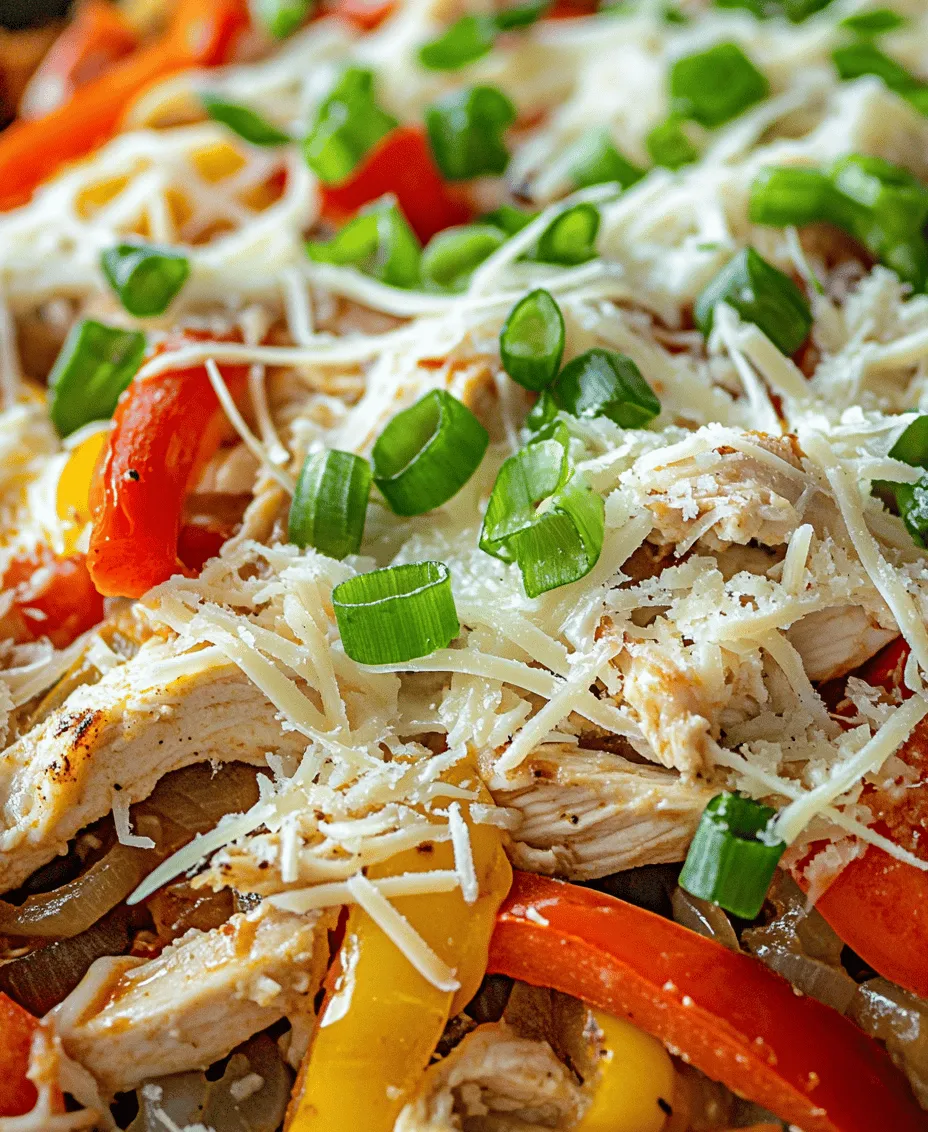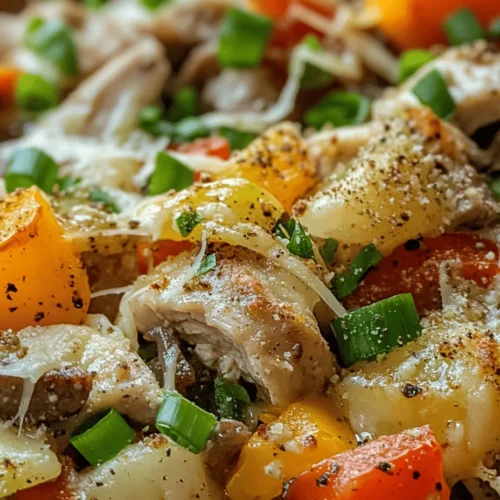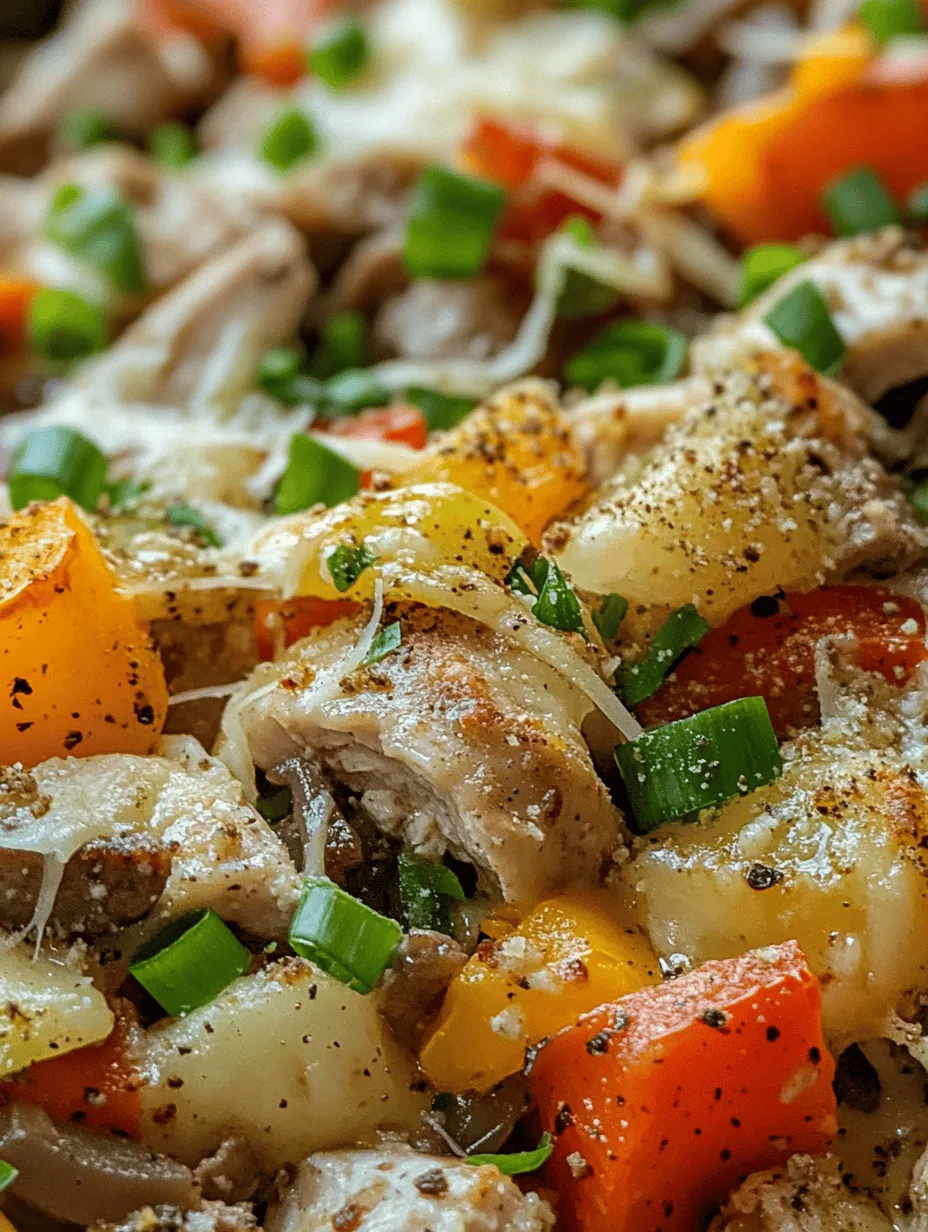Introducing the Philly Chicken Cheesesteak Casserole, a delicious and comforting dish that reimagines the beloved cheesesteak sandwich in a family-friendly casserole format. This dish is not only a feast for the taste buds but also a visual delight, showcasing an array of vibrant colors and textures. With tender chicken, fresh vegetables, and a rich melty cheese blend, it’s the perfect option for family dinners or gatherings. In this article, we will explore the origins of the cheesesteak, the unique qualities of this casserole version, the essential ingredients involved, and the preparation steps to create this satisfying meal.
The Allure of the Cheesesteak
Understanding the Popularity of Cheesesteaks
The cheesesteak sandwich, often simply referred to as a cheesesteak, is a culinary icon that originated in Philadelphia, Pennsylvania. Its history dates back to the early 1930s when Pat Olivieri, a hot dog vendor, decided to grill some beef and serve it in a sandwich. This simple yet mouthwatering creation quickly gained popularity, leading to the establishment of the first cheesesteak shop in the city. Over the decades, the cheesesteak has evolved, becoming a staple of Philadelphia’s culinary landscape and a beloved comfort food across the United States.
What defines a traditional cheesesteak? At its core, the sandwich is built upon a foundation of thinly sliced ribeye beef, sautéed onions, and melted cheese, all served on a soft hoagie roll. The most popular cheese choices are Cheez Whiz, provolone, or American cheese, each contributing its unique flavor and texture to the sandwich. The combination of savory beef, sweet onions, and gooey cheese creates a satisfying and indulgent meal that captures the hearts of food lovers everywhere.
What Makes the Casserole Version Unique
While the classic cheesesteak is undoubtedly delicious, the Philly Chicken Cheesesteak Casserole offers a unique twist that combines convenience with flavor. One of the most significant advantages of this casserole version is its one-dish nature. Gone are the days of messy sandwiches; this recipe allows you to enjoy all the flavors of a cheesesteak in a single, easy-to-prepare dish. It simplifies meal prep and cleanup, making it an ideal option for busy weeknights or when hosting a gathering.
In addition to convenience, the casserole format allows for the harmonious blending of flavors and textures. The tender chicken mingles beautifully with sautéed vegetables, while the creamy cheese melts into a luscious sauce that envelops every bite. Topped with a crunchy layer of breadcrumbs, the casserole offers a delightful contrast in textures, making each mouthful an enjoyable experience.
Ingredients Breakdown
Essential Ingredients for Philly Chicken Cheesesteak Casserole
Creating the perfect Philly Chicken Cheesesteak Casserole starts with selecting the right ingredients. Here’s a closer look at what you’ll need to make this delightful dish:
Chicken
The star of this casserole is undoubtedly the chicken. Opt for boneless, skinless chicken breasts or thighs, as they are juicy and flavorful. Chicken thighs tend to be more forgiving in terms of moisture, making them a great choice for this recipe. When cooked properly, the chicken will absorb the flavors of the seasonings and meld beautifully with the other ingredients. If you’re looking for a quicker option, pre-cooked rotisserie chicken can also work in a pinch, allowing you to save time without sacrificing flavor.
Vegetables
To enhance the dish’s nutritional profile and add a pop of color, incorporate a medley of fresh vegetables. The classic combination of bell peppers and onions is a must, as they complement the flavors of the chicken and cheese while adding sweetness and crunch. Choose a variety of bell pepper colors—red, yellow, and green—for visual appeal and a range of nutrients. Additionally, you can include mushrooms or spinach for added depth of flavor and nutrition.
Cheese
Cheese is a fundamental component of any cheesesteak, and this casserole is no exception. A blend of cream cheese, provolone, mozzarella, and Parmesan works wonders to create a rich, creamy texture. Cream cheese adds a velvety mouthfeel and helps bind the sauce, while provolone and mozzarella contribute a delightful cheesiness that melts beautifully. Parmesan can be sprinkled on top for an extra layer of flavor and a golden crust.
Pasta
Incorporating pasta into the casserole transforms it into a more filling meal. Opt for short pasta shapes like penne or rotini, as they hold the sauce well and offer a satisfying bite. Cook the pasta al dente before adding it to the casserole dish to ensure it doesn’t become mushy during baking.
Seasoning
Seasoning is key to elevating the flavors in this casserole. Italian seasoning is a perfect complement, as it incorporates a blend of herbs like oregano, basil, and thyme, which work harmoniously with the chicken and vegetables. A sprinkle of garlic powder and black pepper can also enhance the overall taste, giving the dish an aromatic kick.
Preparation Steps
Prepping Your Ingredients
The first step in creating your Philly Chicken Cheesesteak Casserole is to prepare your ingredients efficiently. Start by dicing the chicken and slicing the vegetables. For the chicken, cut it into bite-sized pieces to ensure even cooking. Using a sharp knife and a cutting board, maintain a firm grip to make the process easier.
When it comes to the vegetables, slice the bell peppers and onions into thin strips. The goal is to have them cook evenly, so try to keep the pieces uniform in size. If you’re adding mushrooms or spinach, chop them as needed.
Using fresh ingredients is crucial for optimal taste. Fresh vegetables not only provide better flavor but also retain more nutrients. Take the time to wash and dry your produce before slicing, ensuring that any dirt or residues are removed.
Cooking Process
Once your ingredients are prepped, it’s time to begin the cooking process. Start by heating a large skillet over medium heat and adding a drizzle of olive oil. This will serve as the base for sautéing your chicken and vegetables.
Sautéing Chicken and Vegetables
Add the diced chicken to the skillet and season it with salt, pepper, and a sprinkle of Italian seasoning. Cook the chicken for about 5-7 minutes, stirring occasionally, until it is browned on the outside and cooked through. The chicken should reach an internal temperature of 165°F (75°C) for food safety.
Once the chicken is cooked, remove it from the skillet and set it aside on a plate. In the same skillet, add the sliced bell peppers and onions. Sauté them for about 5 minutes until they are tender and slightly caramelized. The natural sweetness of the onions will really shine through, enhancing the overall flavor of the casserole.
Achieving the Perfect Cheese Blend
Now it’s time to create the creamy cheese sauce. Reduce the heat to low and add the cream cheese to the skillet, stirring until it begins to soften. Gradually mix in the provolone and mozzarella, allowing the cheeses to melt completely into a smooth sauce.
For added richness, you can also stir in a splash of chicken broth or milk to achieve your desired consistency. Once the cheese has melted, return the cooked chicken and sautéed vegetables to the skillet, stirring everything together to ensure the ingredients are well combined.
Assembling the Casserole
With the flavorful chicken, vegetables, and cheese sauce ready, it’s time to assemble the casserole. Preheat your oven to 350°F (175°C) while you layer the ingredients in a greased baking dish. Begin by adding the cooked pasta to the bottom of the dish, followed by the chicken and vegetable mixture. Pour the creamy cheese sauce over the top, ensuring everything is evenly coated.
To finish, sprinkle a generous amount of Parmesan cheese and breadcrumbs over the casserole for a crunchy topping that contrasts beautifully with the creamy filling. This step adds an extra layer of flavor and texture, making each bite even more satisfying.
Now that you’ve prepped, cooked, and assembled your Philly Chicken Cheesesteak Casserole, you’re ready to bake it to perfection.
Stay tuned for the next part, where we’ll dive into the baking process, serving suggestions, and tips to make this casserole your new favorite dish!

How to Layer Ingredients for Even Cooking and Flavor Distribution
Creating a delicious Philly Chicken Cheesesteak Casserole begins with the proper layering of ingredients. The goal is to ensure that every bite is a harmonious blend of flavors and textures. Start by evenly distributing the cooked chicken and sautéed vegetables across the base of your baking dish. This creates a flavorful foundation for the casserole.
Next, sprinkle a portion of the cooked pasta over the chicken and vegetables. This not only adds texture but also helps absorb any flavorful juices that develop during baking. Follow this layer with a generous amount of cheese, followed by additional layers of pasta and chicken mixture. This layering technique is vital as it allows the cheese to melt uniformly, creating a gooey, cheesy experience in each serving.
It’s crucial to reserve some cheese for the topping. This final layer of cheese will create a beautiful, golden crust that adds an appealing visual element and enhances the overall flavor. When baked, this cheese layer forms a delightful contrast with the tender chicken and pasta beneath, ensuring that every forkful is a perfect blend of creaminess and savory goodness.
Baking Instructions
The Baking Process
Baking the casserole is the final step that transforms your layered masterpiece into a comforting dish. Preheating the oven to the right temperature—typically around 350°F (175°C)—is essential. Preheating ensures that the casserole starts cooking evenly from the moment it goes into the oven. This step not only helps the cheese melt beautifully but also allows the flavors to meld together, creating a cohesive dish.
Once your oven is preheated, cover the casserole with foil for the first part of the baking process. This traps steam, allowing the ingredients to cook through without drying out. Bake for about 25-30 minutes, then remove the foil and sprinkle the reserved cheese on top. Return the casserole to the oven and bake for an additional 10-15 minutes or until the cheese is bubbly and golden brown.
To determine when your casserole is perfectly cooked, look for a few visual cues. The edges should be slightly bubbling, and the cheese on top should be melted and starting to brown. A good practice is to insert a knife into the center of the casserole; if it comes out hot and clean, your dish is ready to serve.
Serving Suggestions
Garnishing Your Casserole
Serving your Philly Chicken Cheesesteak Casserole can be as creative as the dish itself. For added flair, consider garnishing with freshly chopped parsley or chives to introduce a pop of color and freshness. A drizzle of balsamic glaze or a sprinkle of crushed red pepper flakes can elevate the dish, adding a touch of sophistication and an extra kick.
When it comes to presenting the dish, serve it in the baking dish itself for a rustic look, or transfer individual portions onto plates for a more formal presentation. Pairing the casserole with a side salad can enhance the meal, providing a refreshing contrast to the rich and cheesy casserole.
Suggested Sides That Complement the Casserole
To round out your meal, consider serving side dishes that balance the heartiness of the casserole. A light mixed green salad with a zesty vinaigrette can provide a refreshing contrast. Alternatively, roasted vegetables or garlic bread can complement the flavors of the casserole, making for a satisfying meal. For a more traditional approach, crispy potato wedges or sweet potato fries can add a comforting touch that echoes the classic cheesesteak vibe.
Nutritional Analysis
Evaluating the Nutritional Value of the Casserole
Understanding the nutritional content of your Philly Chicken Cheesesteak Casserole is helpful for those monitoring their dietary intake. A typical serving of this casserole contains approximately 400-500 calories, depending on the specific ingredients used and portion sizes. The dish is rich in protein, primarily from the chicken and cheese, which supports muscle health and provides sustained energy.
The main ingredients—chicken, peppers, onions, and pasta—offer various health benefits. Chicken is an excellent source of lean protein, while bell peppers are high in vitamins A and C, contributing to immune health and skin vitality. The addition of whole grain pasta can increase fiber intake, promoting digestive health.
Breakdown of Calories and Key Nutrients Per Serving
Here’s a rough breakdown of key nutrients per serving:
– Calories: 450
– Protein: 30g
– Carbohydrates: 40g
– Fat: 20g
– Fiber: 3g
These values can vary based on the specific ingredients and quantities used, but they provide a general idea of the casserole’s nutritional profile.
Variations and Substitutions
Customizing Your Philly Chicken Cheesesteak Casserole
One of the best things about this casserole is its versatility. If you’re looking to customize your dish, consider the following variations:
– Vegetarian Options: For a meatless version, replace the chicken with sautéed mushrooms or lentils. You can use a combination of different vegetables like zucchini, eggplant, or spinach to create a flavorful and nutrient-rich casserole. Swap out the cheese with a plant-based alternative to keep it vegan-friendly.
– Alternative Pasta Choices: For those with dietary restrictions, there are many pasta alternatives available. Zucchini noodles, whole grain pasta, or gluten-free pasta can work well in this recipe, offering a healthier or allergen-friendly option.
– Spicy Twists: If you prefer a bit of heat, consider adding sliced jalapeños or a few dashes of hot sauce to the chicken mixture. This not only adds flavor but also gives your casserole a spicy kick, making it more exciting for those who enjoy bold flavors.
Storing and Reheating
Best Practices for Storing Leftovers
If you find yourself with leftovers after enjoying your Philly Chicken Cheesesteak Casserole, it’s essential to store them properly to maintain their freshness. Allow the casserole to cool to room temperature before transferring it to an airtight container. It can be stored in the refrigerator for up to three to four days.
If you want to keep it longer, consider freezing portions of the casserole. Wrap the individual portions tightly in plastic wrap and then place them in a freezer-safe container. This method ensures that your casserole stays fresh for up to three months.
Reheating Tips to Maintain Texture and Flavor
When it’s time to enjoy your leftovers, reheating properly is key to preserving the casserole’s taste and texture. For the best results, reheat the casserole in the oven. Preheat the oven to 350°F (175°C), cover the casserole with foil, and heat for about 25-30 minutes or until warmed through. This method helps maintain the creamy texture of the cheese and prevents the casserole from drying out.
If you’re short on time, you can also reheat individual portions in the microwave. Use a microwave-safe dish and cover it to retain moisture, heating for 1-2 minutes or until hot.
Conclusion
Philly Chicken Cheesesteak Casserole is not just a meal; it’s an experience that brings together the beloved flavors of a classic sandwich in a new and exciting way. Whether you’re serving it for a weeknight dinner or a special occasion, this casserole is sure to satisfy and impress. With its straightforward preparation and room for customization, it’s a recipe to keep in your culinary repertoire, ensuring that everyone at the table leaves happy and full.
This casserole’s versatility allows for numerous variations, making it an excellent staple for any kitchen. From vegetarian adaptations to spicy versions, there’s a way to cater to everyone’s tastes. So gather your ingredients, layer them thoughtfully, and enjoy the comforting flavors of this delightful dish. Your family and friends will be asking for seconds and thirds, making it a cherished addition to your meal rotation.



